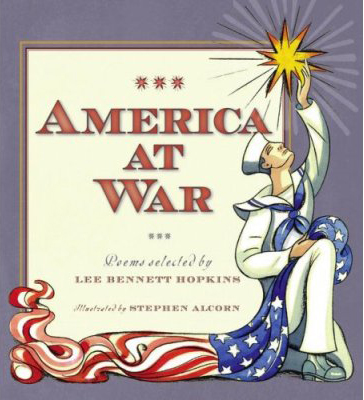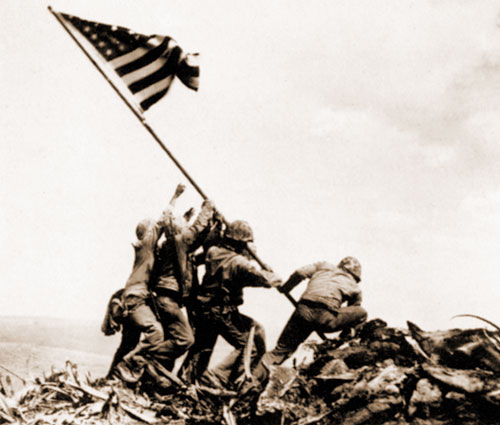Patriotic. Moving. History-in-the-Making.
Stars and Stripes Forever. World Connection.
America At War: Poems Selected by Lee Bennett Hopkins
Written by Lee Bennett Hopkins. Illustrated by Stephen Alcorn.
Published by Margaret K. McElderry Books, 2008.
From Booklist
*Starred Review* This handsome anthology, expressing Americans’ varied experience during wartime, is a fine selection of poems accessible to children. Each poem appears on one or two pages, accompanied by strong, yet graceful illustrations. Though not all content is tied to a particular conflict and not all the poets are American, the poems work well together to represent book’s sections: the American Revolution, the Civil War, World Wars I and II, and the wars in Korea, Vietnam, the Persian Gulf, and Iraq. Each section begins with a short quote from a philosopher, political leader, or military officer and a few brief comments on the conflict. Once the poems begin, though, readers will be transported from the broad view to the particulars by the thoughts, words, and experiences of people affected by war in different ways. The poems will touch readers with their sharp poignancy and undeniable power. Throughout the well-designed book, the expressive watercolor artwork enhances the poetry and gives a sweeping sense of unity and dignity to diverse points of view. Grades 5-8. --Carolyn Phelan
CBC/NCSS Notable Children's Book in Social Studies
CBC/NCSS Notable Social Studies Trade Book

In America At War, young poets will be able
to boost their poetry skills as they read through a series of poems that
describe the lively and well-known American Wars from the times of the American
Revolution to the Iraqi War in the 1990s. These poems were not selected at
random, but chosen by a highly decorated poet, Lee Bennett Hopkins, who have
selected famous poets such as Walt Whitman and Langston Hughes for this beautifully,
illustrated slideshow of militaristic events. As students read these poems,
they are able to visualize the scene of war through the descriptive and
illustrative language. Although war is heavily taught in a negative way, America At War pushes for positivity as
it gives acknowledgement to the current soldiers and veterans who serves in wars
and celebrates their determination, courageousness, and loyalty to protecting
our nation.
Extras: Lee Bennett Hopkins's America At War is a patriotic and descriptive book that will engage and possibly provoke new poetic ideas for your student's writing activities. It is divided into eight parts, describing the past and current wars that America have faced. The text is very personable and it may be a sensitive to some students as some may have grandparents or parents who were or now soldiers. Overall, have students be proud of the veterans and current soldiers who dedicate their time to protecting our nation and giving us pride. Painting illustrations by the internationally-acclaimed painter and printmaker are included in the book to motivate the student's imagination and how one may perceive the poem through a painting. An introduction and a table of contents is provided as it will give students a preview of the book before they read, and an epilogue to end the story. Acknowledgments and indexes of authors, titles, and first lines are included for student access. Lastly, on the jacket, there is a brief summary of the author and illustrator, great for students to view before reading.
Literary Genre: Poetry, Non-fiction, Historical, Patriotic
Reading Level: Lexile Framework NP, Grade 4/5
Suggested Delivery: Independent Read, Small Group Read or Read-Aloud
ISBN-13: 978-1416918325
****************************************************************************
Teachers... Here are some resources to help
you teach America At War: Poems Selected by Lee Bennett Hopkins
Author's Site: Lee Bennett Hopkins - This link is a great source for teachers and students who want to know more about the author, who is considered to be the most distinguished poet and anthologists. This site includes a biography of the author, journal entries, books that the author wrote, awards, and contact information. Great to review for teachers and students before reading.
Illustrator's Site: Stephen Alcorn - This link is a great source for teachers and students as it provides more information on the internationally-acclaimed painter and printmaker, Stephen Alcorn, who illustrates many of the paintings in the book. The site includes a variety of artwork that he has done. Great to review before reading so that teachers can grab student's interest.
PBS: Timeline of U.S. Military Actions and Wars, 1775-1994 - This link is a great source for students to review before and during reading as it provides a timeline of all the wars that the United States was involved in. There are also side links that will direct students to videos, war letters, related reading, lesson plans and activities, and photographs.
ReadWriteThink: What is Poetry? - This link is a great source for teachers to view before having students read poetry. It is a lesson plan that will teach students the structure of poetry and what poetry consists of. It also includes a variety of activities, related resources, and many more.
Reading Rockets: Using Poetry to Teach Reading - This link is a great source for teachers to review before having students read poetry. In this link, it provides strategies and skills on how to use poetry to teach reading, related links, management tips, and a list of favorite children's poets/poems.
America's Library - This link is a credible government website that is perfect for teachers and students. Teachers or students are able to research America's best, view videos and photographs, enjoy fun activities and games, and overall, learn more about America's past. Great to review before, during, or after reading.
April is National Poetry Month - This link is an amazing website for teachers and students to enjoy. Teachers and students are able to view this link and celebrate April, which is National Poetry Month and understand why this month is the time to celebrate poetry. The source also provides interactive poetry games, worksheets and activities, lesson plans and teacher resources, videos, poetry involved with other disciplines, and many more. Great for teachers and students to review before, during or after reading.
Key Vocabulary: taxation, fatalities, sweltering, sodden, epitaph, dutifully, musketry, slaughter, corpses, whippoorwill, recuperated, ominous, calvary, skirmish, peril, serene, stifled, verdun, tremulous, groat, gallantly, irony, unfurled, indelible, succumb, preempted, consoled, eulogy, dirges, barren, preemptive, coalition, collateral, casualties, Communist
Teaching Suggestions:
- Use this text to explore other poets and their poetry such as Shel Silverstein, Walt Whitman, Langston Hughes, or Theodor Seuss Geisel. To learn that all poems are different on topic, style, and inspiration.
- Use this text to explore other structures of poems, such as haikus, sonnets, free verse, etc.
- Use this text in History/Social Studies to learn about the different American Wars through an artistic perspective (poetry).
- Use this text to explore the different types of emotions people go through when war is the subject.
- Use this text to increase patriotism, loyalty, proudness, and loving of our country.
- Use this text in Music to focus on the type of rhythm or beat the poet used to write his or her poems. Is this style consecutive in all of the poems or are they different? What does he or she include or exclude?
Comprehension Strategies:
- Before Reading:
- Introduce to readers that they will be reading a selection of poetry depicting the wars that prideful American soldiers have fought in to protect our country. Ask students what the word "war" signifies or means to them? Does it bring a positive or negative feeling? What other kind of feelings does war illustrate or depict in one's head? What is the purpose of war or why do people have wars? Is war sometimes good or bad, does it depend on the situation at hand? Asking these questions to students will have them thinking and increasing their schema of this concept while they read these poems. Please make sure to also be sensitive while discussing this subject as some of your students in your class may have parents or relatives who are current or past soldiers fighting in the Middle East.
- During Reading:
- During the read-aloud, have students have a copy of the book to follow along. After, reading each poem, ask questions that will have students describe the major theme or purpose of the poem, if there are rhymes or alliterations, if the language is descriptive and figurative, or other poem characteristics. After reading several different poems, have students discuss the similarities or differences in each poem. Then, inform students to use split-page note-taking, have students write down a stanza or phrase of the poem on one side, then have students analyze it on the other side. This will build student's inferential comprehension.
- After Reading:
- Have students read the poems independently or out loud. If students chooses to read out-loud, have students express the language or emotion coming from the poem. Have students dramatize and visualize that they are at the scene of war. This is a great way to assess student's fluency because it will measure if students understand the expression from the text and are able to portray it through their reading.
- If possible, have a veteran or current soldier come into the class to share their experiences in the American war that they fought. Have students prepare a list of questions that they would like to ask the guest speaker. After, have students compare and contrast what the speaker said about their experience in the war he or she talked about to the poem that was written in the book. Did they have the same perspective of the war like the poem did?
- Have students prepare Care Packages to the current soldiers and have students write to the soldiers discussing how proud they are for taking their time to protect our nation, or combine this after-reading activity with the Student Writing Activity below.

Student Writing Activity: Have students create their own poem about the current wars that are happening in the world. Students can also turn their poems in a musical piece, such as a Rap. Before starting the poem, have students research the different wars and have them select a war that affects or interests them the most. Have students research the war. Then have students write a poem about their perspective on the war. Remind students to use alliterations, simile, metaphors, rhymes, literary devices, beat, descriptive language, and other characteristics of poems in their work. Have students make it original and stress to them to write a poem on what they feel based on the war they chose.
Hopkins, L. B., & Alcorn, S. (2008). America at war: poems selected by Lee Bennett Hopkins. New York: Margaret K. McElderry Books.









No comments:
Post a Comment